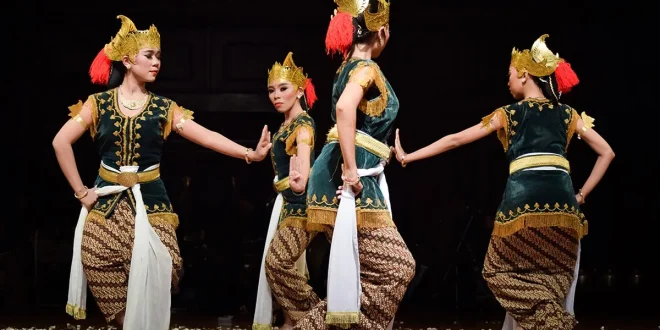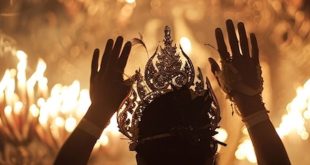Traditional Dance Events Indonesia: A Cultural Journey Awaits
Indonesia, a vibrant tapestry of cultures and traditions, offers a captivating glimpse into its rich heritage through its traditional dance events. These events not only showcase the mesmerizing artistry of Indonesian dance but also serve as a gateway to understanding the diverse cultural narratives that shape this archipelago. “Traditional Dance Events Indonesia” is your passport to exploring these awe-inspiring spectacles that breathe life into Indonesia’s historical and cultural identity.
In this article, we delve into the significance of traditional dance events in Indonesia, highlighting how they foster cultural appreciation and community spirit. Whether you’re a traveler seeking to enrich your cultural knowledge or a local eager to reconnect with your roots, these dance events offer something truly special. Expect to uncover practical tips on attending these events, from understanding the symbolism behind the intricate movements to knowing the best times and locations to witness these performances.
By the end of this exploration, you’ll be inspired to partake in these cultural celebrations, gaining a deep appreciation for the artistry and tradition that define Indonesian dance. Embark on this cultural journey and let “Traditional Dance Events Indonesia” be your guide to an unforgettable experience.
Introduction: Traditional Dance Events in Indonesia
Overview of Traditional Dance Events in Indonesia
Traditional dance events in Indonesia are vibrant celebrations that showcase the archipelago’s rich cultural diversity and artistic heritage. These events are not only visually captivating but also provide a deep insight into the historical and social fabric of Indonesian communities. Held year-round across the country, these dance festivals often coincide with religious or cultural celebrations, drawing both locals and international visitors alike.
One of the most renowned dance events is the Bali Arts Festival, which features a grand showcase of Balinese traditional dance and arts. This month-long event is a key highlight in Bali’s cultural calendar and offers a platform for local artists to exhibit their talents. For more on this, visit our page on the Bali Arts Festival Celebration Balinese Culture.
In Java, the Yogyakarta Art Festival is another significant event, bringing together traditional and contemporary performances. The festival is a melting pot of Javanese culture, featuring classical dance forms such as the graceful Bedhaya and the dynamic Jathilan.
Practical Tips for Attending:
- Plan Ahead: Popular events like the Bali Arts Festival can attract large crowds. Booking tickets and accommodations in advance is advisable.
- Cultural Sensitivity: Understanding the cultural context and respecting local customs enhance the experience. Participate with an open mind and dress appropriately for the occasion.
- Engage with Locals: Engaging with local performers and attendees can provide deeper insights into the significance of the dances and their origins.
For a broader view of cultural celebrations, refer to our guide on Cultural Festivals in Indonesia.
Significance of Dance in Indonesian Culture
Dance in Indonesian culture is much more than mere performance; it is a profound expression of identity, history, and community life. Each region in Indonesia boasts its own unique dance styles, often passed down through generations, reflecting local traditions, beliefs, and social values.
Traditional dance in Indonesia serves as a medium for storytelling and is integral to rituals and ceremonies. For example, the Saman dance from Aceh, known for its energetic movements and harmonious clapping, is performed during important cultural gatherings and is recognized by UNESCO as an intangible cultural heritage.
In Bali, dance is intertwined with Hindu religious practices, where performances like the Barong and Legong are essential components of temple ceremonies. These dances are not merely for entertainment but are believed to maintain spiritual balance and protect the community from evil spirits.
Insights for Cultural Explorers:
- Understanding Symbolism: Many dances incorporate symbolic gestures and costumes. Researching these elements ahead of time can enrich the viewing experience.
- Participate in Workshops: Many cultural centers and festivals offer dance workshops. Participating can provide a hands-on understanding of the dance forms and their cultural contexts.
- Explore Diverse Regions: Each Indonesian island has distinct dance traditions. Exploring different regions, from Aceh to Papua, can provide a comprehensive understanding of Indonesia’s dance heritage.
For those keen on delving into the health and wellness aspects of dance, exploring resources like Your Health Tips Articles and Health, Home and Travel Tips can offer valuable insights.
By immersing oneself in these traditional dance events, travel enthusiasts, cultural explorers, and dance aficionados can gain a profound appreciation for Indonesia’s rich cultural tapestry, inspiring a deeper connection to the diverse communities within the archipelago.
Popular Traditional Dance Events
Bali Arts Festival
The Bali Arts Festival is a month-long celebration held annually in Denpasar, showcasing the rich tapestry of Balinese culture through traditional dance, music, and crafts. This event provides a platform for both local and international artists to present their skills in a variety of performances, making it one of the most significant traditional dance events in Indonesia.
During the festival, visitors can experience a plethora of cultural dance performances, including the mesmerizing Legong and Barong dances, which are intrinsic to Balinese heritage. The festival typically kicks off with a grand parade featuring participants from all of Bali’s regencies, setting the stage for the vibrant events that follow.
Practical Tips for Attending:
- Timing: The festival usually takes place from mid-June to mid-July. Plan your visit accordingly to catch the opening parade.
- Location: Events are held at the Bali Art Centre in Denpasar. Arrive early to secure good seating for popular performances.
- Cultural Etiquette: Wear modest clothing and be respectful of the performers and local customs.
- Learn More Here
For more insights into this celebration, visit our dedicated page on Bali Arts Festival Celebration Balinese Culture.
Pasola Festival
The Pasola Festival is a thrilling event celebrated by the Sumba people of East Nusa Tenggara. This festival combines cultural dance with a traditional spear-fighting game, marking the beginning of the rice planting season. The traditional dance celebrations here are a prelude to the Pasola competition, where participants on horseback engage in a mock battle.
The festival is deeply rooted in the Marapu belief system, which emphasizes harmony with nature and ancestral spirits. The dance performances are not only vibrant but also serve as a spiritual ritual to ensure a bountiful harvest.
Practical Tips for Attending:
- Best Time to Visit: The festival dates vary each year, based on the lunar calendar, so it’s advisable to check with local sources or tourism offices beforehand.
- Location: Held in various locations across West Sumba. Waikabubak is a popular spot to experience it.
- Safety: Stand back from the main arena during the Pasola battle for safety reasons and follow the guidance of local authorities.
- Health, Home and Travel Tips
For more cultural events, explore Cultural Festivals in Indonesia.
Javanese Ramayana Ballet
The Javanese Ramayana Ballet is a spectacular performance that brings the ancient Hindu epic, the Ramayana, to life through dance and music. This Indonesian dance heritage is most famously performed at the Prambanan Temple complex near Yogyakarta, under the open night sky, providing a backdrop that enhances the mystical allure of the performance.
The dance incorporates intricate movements and expressive gestures, accompanied by a traditional gamelan orchestra, making it a must-see for dance aficionados and those interested in Indonesian dance festivals.
Practical Tips for Attending:
- Performance Schedule: The Ramayana Ballet is performed regularly, especially during the dry season (May to October) when outdoor performances are more frequent.
- Tickets: Purchase tickets in advance, especially during peak tourist season, to ensure a spot.
- Experience: Arrive early to explore the Prambanan Temple complex before the show starts to fully appreciate the setting.
- Your Health Tips Articles
These traditional dance events not only offer entertainment but also provide deep insights into Indonesia’s rich cultural tapestry, ensuring that visitors leave with a greater appreciation for the country’s artistic and spiritual heritage.
Experiencing Indonesian Dance
Indonesian traditional dance events offer a vibrant window into the country’s rich cultural heritage. With a diverse tapestry of dance styles, each region of Indonesia brings its own unique flair to the stage. This guide provides insight into the best locations to witness these mesmerizing cultural dance performances and offers practical tips for attending traditional dance celebrations.
Best Locations to Witness Traditional Dances
Indonesia’s traditional dance heritage is celebrated throughout the archipelago, but some locations stand out as must-visit destinations for dance aficionados and cultural explorers.
Bali
Bali, known for its artistic vibrancy, hosts numerous dance events where visitors can experience the enchanting movements of Balinese dance. The Bali Arts Festival is a prominent event, showcasing a variety of traditional dance performances. This month-long festival in Denpasar attracts thousands of visitors eager to immerse themselves in Balinese culture.
Yogyakarta
Yogyakarta is a cultural hub where you can witness Javanese court dances, such as the serene Bedhaya and the lively Wayang Wong. The Ramayana Ballet at Prambanan Temple is a spectacular display of Indonesian dance festivals, combining traditional dance, music, and theatrical performance against the backdrop of the historic temple complex.
Sumatra
In Sumatra, the Tari Piring, or Plate Dance, is a thrilling cultural dance performance where dancers skillfully manipulate plates as part of the choreography. Traditional dance celebrations in Sumatra often occur during local festivals, providing an authentic experience for visitors.
Kalimantan
Kalimantan offers a unique glimpse into the indigenous Dayak culture through its energetic and colorful dances. The Isen Mulang Festival in Palangkaraya is an excellent opportunity to witness these captivating performances, celebrating the region’s diverse cultural heritage.
For more insights into cultural events in Indonesia, you can explore Cultural Festivals in Indonesia.
Tips for Attending Dance Events
Attending dance events in Indonesia can be a rewarding experience, providing deep cultural insights and unforgettable memories. Here are some tips to enhance your experience:
Plan Ahead
- Research Events: Check local event calendars and websites for information on upcoming traditional dance events. Consider the timing of popular festivals such as those in Bali and Yogyakarta.
- Book Early: Popular events like the Bali Arts Festival and Ramayana Ballet can sell out quickly. Book tickets in advance to secure your spot.
Respect Cultural Norms
- Dress Appropriately: Wear modest clothing, as many dance events are held in or near sacred sites. Traditional attire is often appreciated.
- Observe Etiquette: Be mindful of local customs and traditions. Silence your phone and avoid flash photography during performances.
Immerse Yourself
- Engage with Locals: Take the opportunity to speak with local attendees or performers. They can offer valuable insights into the significance and history of the dances.
- Document Your Experience: While respecting local norms, capture moments through photos or notes to remember your experience and share with others.
These tips can help you fully appreciate the beauty and complexity of Indonesian dance heritage. For additional travel advice, visit Your Health Tips Articles and Health, Home and Travel Tips.
By understanding where to go and how to engage respectfully, travel enthusiasts and cultural explorers can deepen their appreciation for Indonesian traditional dance events. This not only enhances personal enjoyment but also supports the preservation of Indonesia’s rich cultural tapestry.
Cultural Impact
How Traditional Dance Preserves Indonesian Heritage
Traditional dance events in Indonesia play a crucial role in preserving the country’s rich cultural heritage. These dances are often passed down through generations, serving as a living archive of Indonesia’s diverse ethnic and cultural history. Each dance tells a story, often rooted in local folklore, religious practices, or historical events, thus maintaining the unique identity of various Indonesian communities.
For example, the Bali Arts Festival Celebration Balinese Culture showcases traditional Balinese dances like the Legong and Barong, which are integral to the island’s cultural tapestry. Such events not only preserve these art forms but also provide a platform for cultural exchange and understanding among visitors.
To maximize your experience at traditional dance celebrations, consider the following tips:
- Research Ahead of Time: Before attending, familiarize yourself with the dance forms and their significance. This will deepen your appreciation and understanding of the performances.
- Engage with Locals: Speak with local performers or community members to gain insights into the cultural context of the dances. Their stories can offer a richer perspective.
- Attend Workshops: Many Indonesian dance festivals offer workshops for visitors. Participating can enhance your cultural exploration and provide a hands-on understanding of the dances.
Role of Dance in Community and Social Gatherings
Dance events in Indonesia are not just performances; they are vital components of community and social gatherings. These events are often communal affairs, fostering social cohesion and shared identity among participants and audiences alike.
Indonesian dance festivals, such as those found in Java and Sumatra, serve as opportunities for communities to come together, celebrate shared traditions, and pass them on to younger generations. For instance, during the Cultural Festivals in Indonesia, traditional dances are performed in public spaces, inviting community participation and interaction.
Dance aficionados and cultural explorers can enhance their understanding of these social gatherings by:
- Observing Rituals and Ceremonies: Pay attention to the rituals associated with dance events. These often reflect the social and spiritual values of the community.
- Participating Respectfully: If invited, join in the dance. Doing so respectfully can be a powerful way to connect with the community and experience the cultural dance performances firsthand.
- Documenting Experiences: Capture the essence of these gatherings through photography or journaling. Sharing your experiences can inspire others to explore Indonesian dance heritage.
By attending these vibrant dance events, travel enthusiasts and cultural explorers can witness firsthand the cultural impact of traditional dances in Indonesia, fostering a deeper appreciation for the country’s rich heritage. For more insights on how to maintain balance and wellness while traveling, consider checking out Your Health Tips Articles and Health, Home and Travel Tips.
Conclusion
Embracing Indonesia’s Rich Dance Traditions
Traditional dance events in Indonesia offer a unique window into the country’s diverse cultural heritage. These events, such as the renowned Bali Arts Festival Celebration Balinese Culture, are not merely performances but vibrant expressions of communal identity and historical narrative. Indonesian dance festivals, like the annual Bali Arts Festival and Yogyakarta’s Ramayana Ballet, showcase a variety of traditional dance celebrations that highlight the country’s vast dance repertoire.
Indonesia’s dance heritage is deeply rooted in its rich history and diverse ethnic groups, each contributing unique styles and stories. For example, the Saman dance from Aceh, recognized by UNESCO as an Intangible Cultural Heritage, is a rhythmic performance that reflects the communal spirit of its people. The intricate movements of the Balinese Legong dance tell stories from ancient Hindu epics, captivating audiences with their grace and precision.
To truly embrace these traditions, travel enthusiasts and dance aficionados should approach these cultural dance performances with an open mind and a respectful curiosity. Engaging with local communities and understanding the significance of each dance can enhance the experience. For those interested in exploring these traditions further, the Cultural Festivals in Indonesia offer a comprehensive overview of events that celebrate Indonesia’s dance heritage.
Final Thoughts on Participating in Dance Events
Participating in dance events in Indonesia is not just about witnessing performances but immersing oneself in a rich cultural tapestry. For those planning to attend traditional dance events in Indonesia, there are a few practical tips to ensure a fulfilling experience:
- Research and Plan Ahead: Identify which festivals or dance events align with your interests. Websites like Your Health Tips Articles and Health, Home and Travel Tips offer useful travel advice that can assist in planning your visit.
- Respect Local Customs: Understanding and respecting local customs is crucial. Dress appropriately, follow event etiquette, and participate respectfully.
- Engage with Local Communities: Interacting with locals can provide deeper insights into the dances and their cultural significance. Consider joining workshops or discussions that often accompany these events.
- Capture the Experience: While photography is a great way to remember your experience, ensure it is permitted and done respectfully, without disrupting performances or participants.
- Support Sustainable Tourism: Engage in responsible tourism practices by supporting local artists, buying authentic crafts, and choosing eco-friendly accommodations.
By embracing these tips, travelers can not only enjoy but also contribute to the preservation of Indonesia’s rich dance traditions. Whether you’re a cultural explorer, a dance aficionado, or simply curious about the world, participating in these events offers a unique opportunity to connect with Indonesia’s vibrant cultural heritage.
FAQ
What are the most popular traditional dance events in Indonesia?
Indonesia is renowned for its rich cultural heritage, and traditional dance events are a vibrant expression of this diversity. Some of the most popular traditional dance events include:
- Bali Arts Festival: Held annually in Denpasar, Bali, this festival showcases a multitude of Balinese dances, including the famous Legong, Barong, and Kecak dances.
- Yogyakarta Arts Festival: This festival features traditional Javanese dances such as the Ramayana Ballet, which is performed at the Prambanan Temple against a backdrop of stunning ancient architecture.
- Toraja Traditional Dance Festival: Celebrated in South Sulawesi, this festival highlights the unique dances of the Toraja people, such as the Ma’gellu dance, which is performed during traditional ceremonies.
- Minangkabau Festival: Taking place in West Sumatra, the festival includes performances of the Tari Piring (Plate Dance), showcasing the agility and grace of the dancers.
These events not only celebrate the traditional dances but also offer a glimpse into the regional customs and traditions of Indonesia.
How do traditional dance events reflect Indonesian culture?
Traditional dance events in Indonesia are a mirror of the country’s diverse cultural tapestry, reflecting its history, beliefs, and social values. Each dance tells a story, often rooted in mythology, folklore, or historical events, and is characterized by specific movements, costumes, and music that are unique to each region.
- Cultural Diversity: Indonesia’s vast archipelago is home to numerous ethnic groups, each with its own distinct dance forms. For example, the Balinese dances are heavily influenced by Hindu mythology, while the Saman dance from Aceh is known for its Islamic influences.
- Spiritual and Religious Significance: Many dances are performed as part of religious ceremonies or rites of passage, reflecting the spiritual beliefs of the local communities. For instance, the Reog Ponorogo dance from East Java is performed during traditional festivals to ward off evil spirits.
- Social Values: Traditional dances often depict the values and norms of Indonesian society, such as respect for elders, the importance of community, and the celebration of nature and life. The Jaipong dance from West Java, for example, celebrates social harmony and communal cooperation.
Through these performances, traditional dance events serve as a powerful medium for preserving and promoting Indonesia’s rich cultural heritage.
What are the best times to attend these dance events?
The best times to attend traditional dance events in Indonesia largely depend on the specific festivals and regional celebrations. Here are some recommendations:
- Bali Arts Festival: Typically held from mid-June to mid-July, this festival is a great opportunity to experience a wide range of Balinese cultural performances.
- Yogyakarta Arts Festival: This event usually takes place in July, making it an ideal time to witness the enchanting Ramayana Ballet at the Prambanan Temple.
- Toraja Traditional Dance Festival: The festival is often celebrated in conjunction with the Rambu Solo’ (funeral ceremonies), which occur between June and August, coinciding with the dry season when travel conditions are favorable.
- Minangkabau Festival: Held around August, this festival offers a chance to see the vibrant Tari Piring and other Minangkabau cultural expressions.
When planning a visit to these events, it is advisable to check the specific dates in advance, as they may vary each year. Additionally, attending these festivals during the dry season (April to October) generally provides more pleasant weather and easier access to outdoor venues.
 Lokasiku Your reference for travel in Indonesia
Lokasiku Your reference for travel in Indonesia


